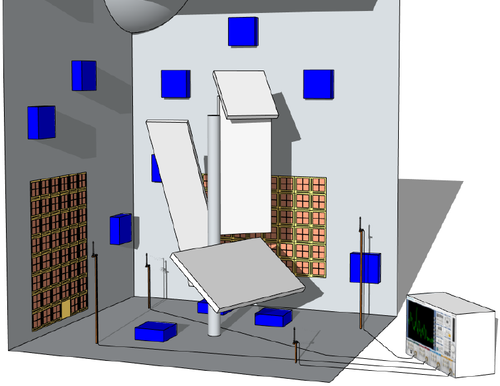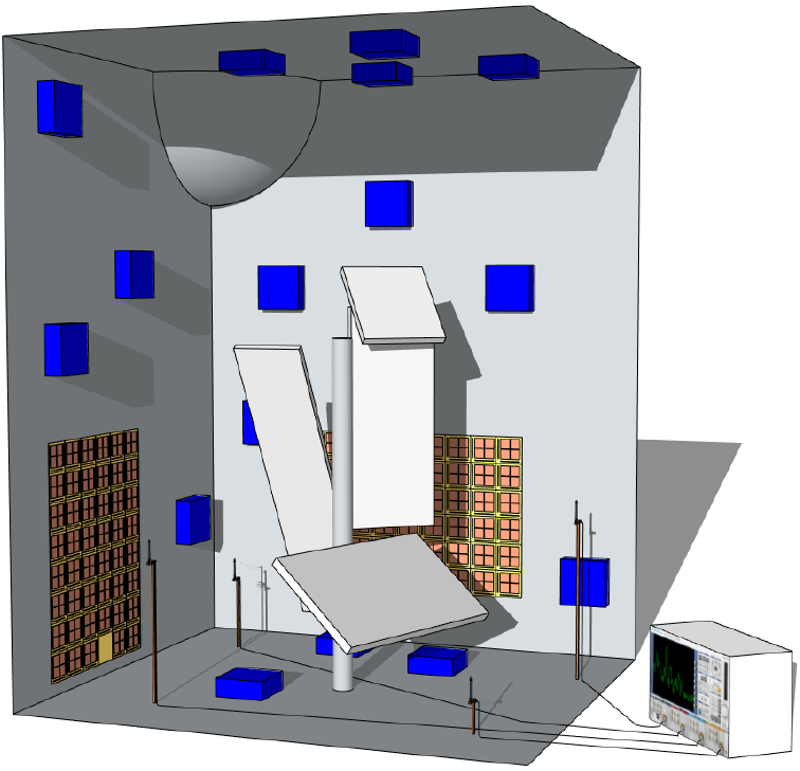Computing with Wi-Fi Waves
Most computers perform operations on digital information in the form of ones and zeros, but it’s also possible to compute with continuous (or analog) information, such as the voltage in an electronic circuit or the amplitude of a light wave. Experiments with wave-based analog computation show that your office or a room in your house could serve as a processor for Wi-Fi waves randomly bouncing off the walls—a reflective array can “shape” the waves to give the desired output. With further optimization, the researchers envision that this type of analog processor could perform operations faster and could consume less energy than current digital machines.
Some of the first electronic computers were analog, but digital computers turned out to be more flexible and more precise. Still, there are tasks, like matrix operations and image processing, for which an analog computation can be faster than its digital counterpart. A recent resurgence of interest in analog computation has focused on metamaterials, structures that can control the paths of light waves. The idea is that the amplitude or phase of incoming waves encodes information, and the metamaterial “processes” that information by scattering the waves and making them interfere with each other. The result of the computation is encoded in the waves produced. The difficulty has been fabricating a metamaterial that can perform the desired scattering effects. Such a device also has the disadvantage of not being reprogrammable.
Philipp del Hougne of the Langevin Institute and Geoffroy Lerosey from the company Greenerwave, both in Paris, have come up with a different approach. Rather than use an engineered material to process incoming waves, they propose starting with engineered light and then using a disordered material to scatter, or “mix,” the waves. Engineering light—known as waveform shaping—is easier to do than constructing high-precision metamaterials, explains del Hougne. Such a system is also reprogrammable, as users can reconfigure the wave-modification commands.
To demonstrate the feasibility of their method, the researchers set up a Wi-Fi network inside a “room” consisting of a meter-wide metal box that contained several furniture-mimicking structures. The researchers used four off-the-shelf Wi-Fi antennas, which filled the room with microwaves and also served as receivers to measure the output signals.
The team performed waveform shaping by installing a so-called metasurface, an array of 88 reflectors, on two walls. They toggled these mirrors between two states—one that reflected waves with a 0° phase shift and the other with a 180° phase shift.
As an initiation step, the researchers recorded the output for a wide variety of metasurface configurations, with the Wi-Fi transmitters all sending the same, standard input signal. This procedure allowed them to characterize the complex scattering experienced by waves in the box and then to program the metasurface to perform various linear operations that are often used in scientific data processing and artificial neural networks. As a representative example, they performed a 4-element Fourier transform, converting a string of four input values, for example, , into a corresponding frequency spectrum, . The system returned the correct result with a 3.8% error.
This analog computation is fast in the sense that the Fourier transform—or any other linear operation—is performed in one shot, whereas a digital computer would ordinarily require operations for four inputs and four outputs. However, the initiation step is time-consuming, and this overhead makes a 4-element, wave-based technique far from competitive. The team speculates that expanding the system to 30 input elements could enable it to calculate at the same speed as current gigahertz digital computers. The researchers also looked at energy expenditures, estimating that their system—once optimized—could use about 100 times less energy than a digital computer.
“The idea of using ‘wave chaos’ to perform computations is very exciting and definitely worth pursuing,” says wave-control expert Steven Anlage from the University of Maryland, College Park. He says the work by del Hougne and Lerosey builds on previous efforts to use wave shaping and a complex scattering medium to focus light [1]. The team’s “clever idea,” according to Anlage, is to introduce a tunable metasurface that guides the scattered waves and results in the analog computation. Vincenzo Galdi, an analog computing researcher from the University of Sannio in Italy, thinks this new wave-based approach could prove practical. He is unsure whether it can become competitive with digital computing, “but the estimated figures in terms of speed and energy efficiency indicate very promising potentials,” he says.
This research is published in Physical Review X.
–Michael Schirber
Michael Schirber is a Corresponding Editor for Physics Magazine based in Lyon, France.
References
- I. M. Vellekoop and A. P. Mosk, “Focusing coherent light through opaque strongly scattering media,” Opt. Lett. 32, 2309 (2007).





